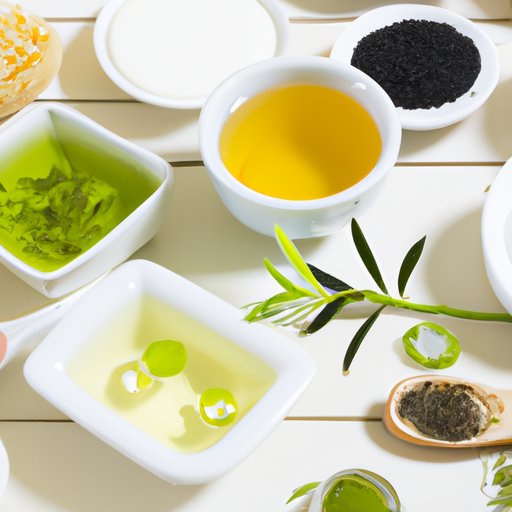Introduction
Tea tree oil is a natural essential oil derived from the Melaleuca Alternifolia plant native to Australia. It has become increasingly popular in recent years as a natural remedy for many ailments, including acne. Tea tree oil can be used in a variety of ways to help reduce breakouts, clear up existing blemishes, and prevent future breakouts from occurring. In this article, we’ll explore the benefits of tea tree oil for acne and provide five ways to incorporate it into your skincare routine.
Create a Facial Cleanser
The first way to use tea tree oil for acne is to create your own facial cleanser. To do this, you’ll need the following ingredients:
- 1 teaspoon of tea tree oil
- 2 tablespoons of liquid castile soap
- 1/4 cup of distilled water
Once you have all the ingredients, mix them together in a small bowl until they are well combined. Then transfer the mixture to an empty bottle or container with a lid, and shake before each use. To use, apply a small amount to dampened skin and massage gently in a circular motion. Rinse off with warm water. Use twice daily for best results.
Use as a Spot Treatment
Another way to use tea tree oil for acne is as a spot treatment. To make a spot treatment, you’ll need the following ingredients:
- 2 drops of tea tree oil
- 1/2 teaspoon of aloe vera gel
- 1/2 teaspoon of apple cider vinegar
Mix all the ingredients together until they are well combined and transfer the mixture to a small container. To use, apply a small amount directly to the affected area and leave on overnight. Rinse off with warm water in the morning. Use as needed.
Add to Your Moisturizer
Adding tea tree oil to your moisturizer can help reduce inflammation and redness associated with acne. To do this, you’ll need the following ingredients:
- 2 drops of tea tree oil
- 2 tablespoons of your favorite moisturizer
Mix the two ingredients together until they are well combined and transfer the mixture to an empty container. To use, apply a small amount to clean skin and massage in a circular motion. Use twice daily for best results.

Make a Tea Tree Oil Face Mask
Making a tea tree oil face mask is a great way to give your skin a deep cleanse and reduce inflammation. To make a face mask, you’ll need the following ingredients:
- 2 drops of tea tree oil
- 2 tablespoons of bentonite clay
- 1 tablespoon of raw honey
Mix all the ingredients together until they are well combined and transfer the mixture to a small container. To use, apply a thin layer to clean skin and leave on for 15-20 minutes. Rinse off with warm water and follow with your normal skincare routine. Use once or twice a week for best results.

Add to Your Bath Water
Adding tea tree oil to your bath water is a great way to get all the benefits of tea tree oil without having to apply it directly to your skin. To do this, you’ll need the following ingredients:
- 5-10 drops of tea tree oil
- 1/2 cup of Epsom salt
Mix the two ingredients together and add to warm bathwater. Soak for 20 minutes and rinse off with warm water. Use once or twice a week for best results.
Conclusion
Tea tree oil is a natural essential oil derived from the Melaleuca Alternifolia plant that has been used for centuries to treat a variety of ailments. It has become increasingly popular in recent years as a natural remedy for acne. Tea tree oil can be used in a variety of ways to help reduce breakouts, clear up existing blemishes, and prevent future breakouts from occurring. We’ve explored the benefits of tea tree oil for acne and provided five ways to incorporate it into your skincare routine. With regular use, you should start to see clearer skin in no time!
Final Thoughts
If you’re looking for a natural way to treat your acne, tea tree oil may be the answer. By incorporating it into your skincare routine in any of the five ways outlined in this article, you should start to see results in no time. Remember to always do a patch test before using any new product and consult a dermatologist if you experience any adverse reactions.


